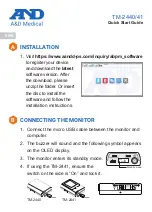
EN
5
Indications for the use of non-automatic sphygmomanometers are any
states that lead to an increase in blood pressure (in particular, the hypertonic
disease, the cardiovascular disease, the heart attack, or the stroke).
The Korotkov method distinguishes five phases of tones:
Phase I: the appearance of first permanent tones, the intensity of which
increases as the air is released from the pressure cuff. Indications of the
sphygmomanometer at the first tone corresponds to the level of systolic
arterial pressure.
Phase II: a “blowing” noise is added to the tones.
Phase III: intensity of tones and noise increases and reaches a
maximum.
Phase IV: a sharp weakening of the tones and disappearance of the
“blowing” noise. This phase can be used to determine the diastolic
arterial pressure in the patients who do not have Phase V tones (tones
are heard up to the zero mark of the sphygmomanometer).
Such patients can include children up to 12-14 years old, pregnant
women, people with hyperthyroidism, aortic insufficiency, high cardiac
minute output, and high body temperature.
Phase V: disappearance of tones. The indication of the sphygmomanometer
at the last tone corresponds to the diastolic blood pressure level*.
*Key Moments of Internal Disease Diagnostics / Editor: Zh. D. Kobalava.
— M.: Peoples’ Friendship University, 2011. — p. 175. — 397 pp.
Which Values are Normal?
The world standard as for the norms of the blood pressure is the
Classification* of the World Health Organization (WHO):
Category
Systolic
Blood Pressure
(mmHg)
Diastolic
Blood Pressure
(mmHg)
Blood pressure too low
< 100
< 60
Blood pressure optimum
100 - 119
60 - 79
Blood pressure normal
120 - 129
80 - 84
Blood pressure slightly high
130 - 139
85 - 89
Blood pressure too high
140 - 159
90 - 99
Blood pressure far too high
160 - 179
100 - 109
Blood pressure dangerously high
≥ 180
≥ 110






























